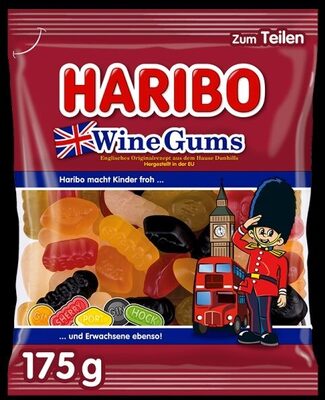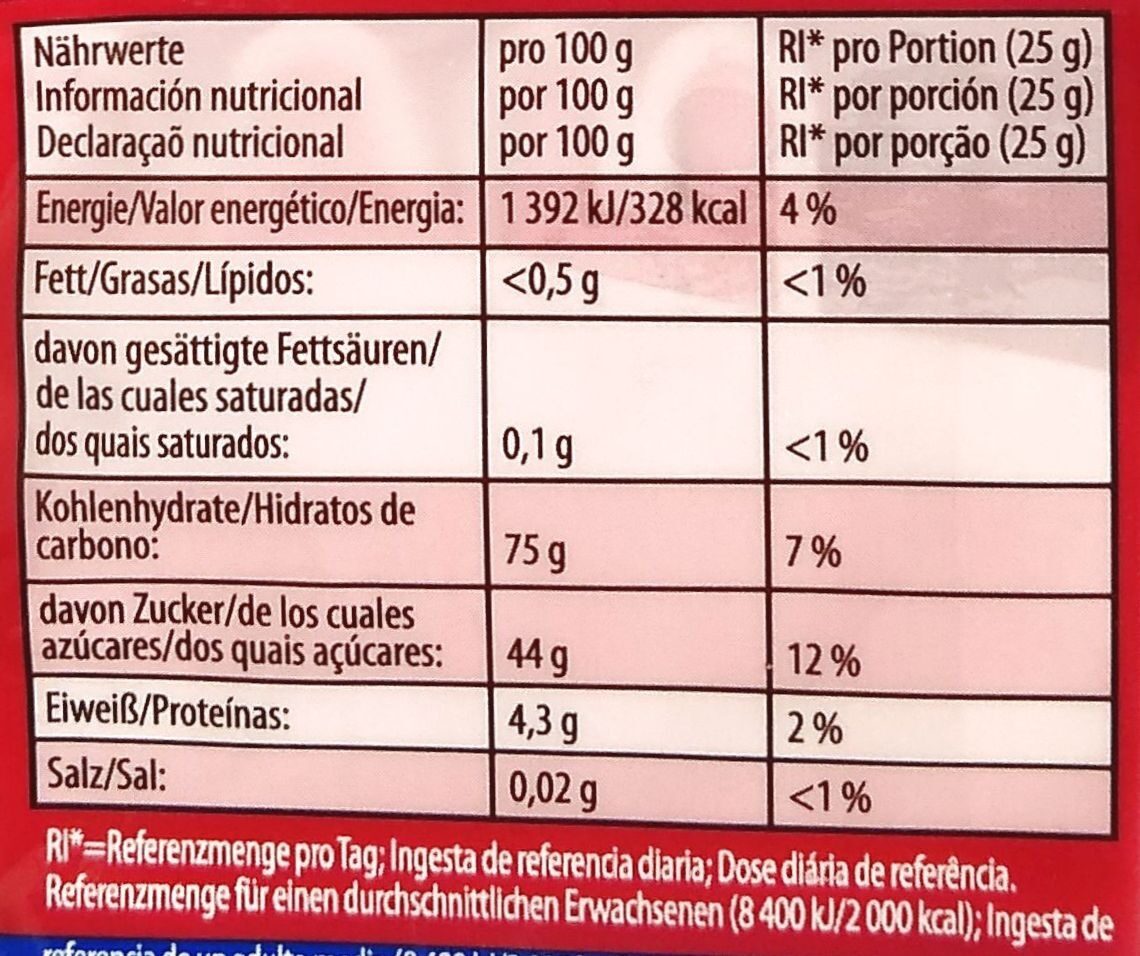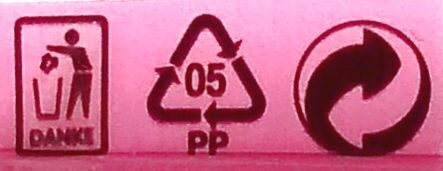Help us make food transparency the norm!
As a non-profit organization, we depend on your donations to continue informing consumers around the world about what they eat.
The food revolution starts with you!
WineGums - Haribo - 175g
WineGums - Haribo - 175g
This product page is not complete. You can help to complete it by editing it and adding more data from the photos we have, or by taking more photos using the app for Android or iPhone/iPad. Thank you!
×
Barcode: 4001686329849 (EAN / EAN-13)
Common name: Englisches Weingummi
Quantity: 175g
Packaging: Plastic, Pp-polypropylene, Bag
Brands: Haribo
Categories: Snacks, Sweet snacks, Confectioneries, Candies, Gummi candies
Manufacturing or processing places: Europäische Union
Link to the product page on the official site of the producer: https://www.haribo.com/de-de/produkte/ha...
Stores: REWE
Countries where sold: Germany
Matching with your preferences
Health
Ingredients
-
28 ingredients
German: Glukosesirup; Zucker; Stärke; Gelatine; Säuerungsmittel: Äpfelsäure, Essigsäure; Sonnenblumenöl; Frucht - und Pflanzenkonzentrate: Saflor, Spirulina, Apfel, Holunderbeere, Orange, Schwarze Johannisbeere, Kiwi, Zitrone, Mango, Passionsfrucht, Aronia, Traube; Aroma; Holunderbeerextrakt; Überzugsmittel: Bienenwachs weiß und gelb; Farbstoff: Pflanzenkohle; Karamellsirup.Allergens: Kiwi, OrangeTraces: Gluten, Milk
Food processing
-
Ultra processed foods
Elements that indicate the product is in the 4 - Ultra processed food and drink products group:
- Additive: E153 - Vegetable carbon
- Additive: E428 - Gelatine
- Additive: E901 - White and yellow beeswax
- Ingredient: Colour
- Ingredient: Flavouring
- Ingredient: Glazing agent
- Ingredient: Glucose
- Ingredient: Glucose syrup
Food products are classified into 4 groups according to their degree of processing:
- Unprocessed or minimally processed foods
- Processed culinary ingredients
- Processed foods
- Ultra processed foods
The determination of the group is based on the category of the product and on the ingredients it contains.
Additives
-
E260 - Acetic acid
Acetic acid: Acetic acid , systematically named ethanoic acid , is a colorless liquid organic compound with the chemical formula CH3COOH -also written as CH3CO2H or C2H4O2-. When undiluted, it is sometimes called glacial acetic acid. Vinegar is no less than 4% acetic acid by volume, making acetic acid the main component of vinegar apart from water. Acetic acid has a distinctive sour taste and pungent smell. In addition to household vinegar, it is mainly produced as a precursor to polyvinyl acetate and cellulose acetate. It is classified as a weak acid since it only partially dissociates in solution, but concentrated acetic acid is corrosive and can attack the skin. Acetic acid is the second simplest carboxylic acid -after formic acid-. It consists of a methyl group attached to a carboxyl group. It is an important chemical reagent and industrial chemical, used primarily in the production of cellulose acetate for photographic film, polyvinyl acetate for wood glue, and synthetic fibres and fabrics. In households, diluted acetic acid is often used in descaling agents. In the food industry, acetic acid is controlled by the food additive code E260 as an acidity regulator and as a condiment. In biochemistry, the acetyl group, derived from acetic acid, is fundamental to all forms of life. When bound to coenzyme A, it is central to the metabolism of carbohydrates and fats. The global demand for acetic acid is about 6.5 million metric tons per year -Mt/a-, of which approximately 1.5 Mt/a is met by recycling; the remainder is manufactured from methanol. Vinegar is mostly dilute acetic acid, often produced by fermentation and subsequent oxidation of ethanol.Source: Wikipedia
-
E296 - Malic acid
Malic acid: Malic acid is an organic compound with the molecular formula C4H6O5. It is a dicarboxylic acid that is made by all living organisms, contributes to the pleasantly sour taste of fruits, and is used as a food additive. Malic acid has two stereoisomeric forms -L- and D-enantiomers-, though only the L-isomer exists naturally. The salts and esters of malic acid are known as malates. The malate anion is an intermediate in the citric acid cycle.Source: Wikipedia
-
E901 - White and yellow beeswax
Beeswax: Beeswax -cera alba- is a natural wax produced by honey bees of the genus Apis. The wax is formed into "scales" by eight wax-producing glands in the abdominal segments of worker bees, which discard it in or at the hive. The hive workers collect and use it to form cells for honey storage and larval and pupal protection within the beehive. Chemically, beeswax consists mainly of esters of fatty acids and various long-chain alcohols. Beeswax has long-standing applications in human food and flavoring. For example, it is used as a glazing agent or as a light/heat source. It is edible, in the sense of having similar negligible toxicity to plant waxes, and is approved for food use in most countries and the European Union under the E number E901. However, the wax monoesters in beeswax are poorly hydrolysed in the guts of humans and other mammals, so they have insignificant nutritional value. Some birds, such as honeyguides, can digest beeswax. Beeswax is the main diet of wax moth larvae.Source: Wikipedia
Ingredients analysis
-
Palm oil free
No ingredients containing palm oil detected
-
Non-vegan
Non-vegan ingredients: E428, E901
-
Non-vegetarian
Non-vegetarian ingredients: E428
-
Details of the analysis of the ingredients
de: Glukosesirup, Zucker, Stärke, Gelatine, Säuerungsmittel (Äpfelsäure), Essigsäure, Sonnenblumenöl, Frucht-und Pflanzenkonzentrate (Saflor), Spirulina, Apfel, Holunderbeere, Orange, Schwarze Johannisbeere, Kiwi, Zitrone, Mango, Passionsfrucht, Aronia, Traube, Aroma, Holunderbeerextrakt, Überzugsmittel (Bienenwachs weiß und gelb), Farbstoff (Pflanzenkohle), Karamellsirup- Glukosesirup -> en:glucose-syrup - vegan: yes - vegetarian: yes - ciqual_proxy_food_code: 31016 - percent_min: 4.16666666666667 - percent_max: 100
- Zucker -> en:sugar - vegan: yes - vegetarian: yes - ciqual_proxy_food_code: 31016 - percent_min: 0 - percent_max: 44
- Stärke -> en:starch - vegan: yes - vegetarian: yes - ciqual_proxy_food_code: 9510 - percent_min: 0 - percent_max: 33.3333333333333
- Gelatine -> en:e428 - vegan: no - vegetarian: no - percent_min: 0 - percent_max: 25
- Säuerungsmittel -> en:acid - percent_min: 0 - percent_max: 20
- Äpfelsäure -> en:e296 - vegan: yes - vegetarian: yes - percent_min: 0 - percent_max: 20
- Essigsäure -> en:e260 - vegan: yes - vegetarian: yes - percent_min: 0 - percent_max: 16.6666666666667
- Sonnenblumenöl -> en:sunflower-oil - vegan: yes - vegetarian: yes - from_palm_oil: no - ciqual_food_code: 17440 - percent_min: 0 - percent_max: 14.2857142857143
- Frucht-und Pflanzenkonzentrate -> en:fruit-and-plant-concentrates - vegan: yes - vegetarian: yes - percent_min: 0 - percent_max: 12.5
- Saflor -> en:safflower - vegan: yes - vegetarian: yes - percent_min: 0 - percent_max: 12.5
- Spirulina -> en:spirulina - vegan: yes - vegetarian: yes - ciqual_proxy_food_code: 20984 - percent_min: 0 - percent_max: 11.1111111111111
- Apfel -> en:apple - vegan: yes - vegetarian: yes - ciqual_food_code: 13050 - percent_min: 0 - percent_max: 10
- Holunderbeere -> en:elderberry - vegan: yes - vegetarian: yes - ciqual_food_code: 13126 - percent_min: 0 - percent_max: 9.09090909090909
- Orange -> en:orange - vegan: yes - vegetarian: yes - ciqual_proxy_food_code: 13034 - percent_min: 0 - percent_max: 8.33333333333333
- Schwarze Johannisbeere -> en:blackcurrant - vegan: yes - vegetarian: yes - ciqual_food_code: 13007 - percent_min: 0 - percent_max: 7.69230769230769
- Kiwi -> en:kiwi - vegan: yes - vegetarian: yes - ciqual_food_code: 13021 - percent_min: 0 - percent_max: 7.14285714285714
- Zitrone -> en:lemon - vegan: yes - vegetarian: yes - ciqual_proxy_food_code: 13009 - percent_min: 0 - percent_max: 6.66666666666667
- Mango -> en:mango - vegan: yes - vegetarian: yes - ciqual_food_code: 13025 - percent_min: 0 - percent_max: 6.25
- Passionsfrucht -> en:passionfruit - vegan: yes - vegetarian: yes - ciqual_food_code: 13016 - percent_min: 0 - percent_max: 5.88235294117647
- Aronia -> en:chokeberry - vegan: yes - vegetarian: yes - percent_min: 0 - percent_max: 5.55555555555556
- Traube -> en:grape - vegan: yes - vegetarian: yes - ciqual_food_code: 13112 - percent_min: 0 - percent_max: 5.26315789473684
- Aroma -> en:flavouring - vegan: maybe - vegetarian: maybe - percent_min: 0 - percent_max: 5
- Holunderbeerextrakt -> en:elderberry-extract - vegan: yes - vegetarian: yes - ciqual_food_code: 13126 - percent_min: 0 - percent_max: 4.76190476190476
- Überzugsmittel -> en:glazing-agent - percent_min: 0 - percent_max: 4.54545454545455
- Bienenwachs weiß und gelb -> en:e901 - vegan: no - vegetarian: yes - percent_min: 0 - percent_max: 4.54545454545455
- Farbstoff -> en:colour - percent_min: 0 - percent_max: 4.34782608695652
- Pflanzenkohle -> en:e153 - vegan: yes - vegetarian: yes - percent_min: 0 - percent_max: 4.34782608695652
- Karamellsirup -> en:caramel-syrup - percent_min: 0 - percent_max: 4.16666666666667
Nutrition
-
Poor nutritional quality
⚠ ️Warning: the amount of fiber is not specified, their possible positive contribution to the grade could not be taken into account.⚠ ️Warning: the amount of fruits, vegetables and nuts is not specified on the label, it was estimated from the list of ingredients: 0This product is not considered a beverage for the calculation of the Nutri-Score.
Positive points: 0
- Proteins: 2 / 5 (value: 4.3, rounded value: 4.3)
- Fiber: 0 / 5 (value: 0, rounded value: 0)
- Fruits, vegetables, nuts, and colza/walnut/olive oils: 0 / 5 (value: 0.809747536977085, rounded value: 0.8)
Negative points: 13
- Energy: 4 / 10 (value: 1392, rounded value: 1392)
- Sugars: 9 / 10 (value: 44, rounded value: 44)
- Saturated fat: 0 / 10 (value: 0.1, rounded value: 0.1)
- Sodium: 0 / 10 (value: 8, rounded value: 8)
The points for proteins are not counted because the negative points are greater or equal to 11.
Nutritional score: (13 - 0)
Nutri-Score:
-
Nutrient levels
-
Fat in low quantity (0.5%)
What you need to know- A high consumption of fat, especially saturated fats, can raise cholesterol, which increases the risk of heart diseases.
Recommendation: Limit the consumption of fat and saturated fat- Choose products with lower fat and saturated fat content.
-
Saturated fat in low quantity (0.1%)
What you need to know- A high consumption of fat, especially saturated fats, can raise cholesterol, which increases the risk of heart diseases.
Recommendation: Limit the consumption of fat and saturated fat- Choose products with lower fat and saturated fat content.
-
Sugars in high quantity (44%)
What you need to know- A high consumption of sugar can cause weight gain and tooth decay. It also augments the risk of type 2 diabetes and cardio-vascular diseases.
Recommendation: Limit the consumption of sugar and sugary drinks- Sugary drinks (such as sodas, fruit beverages, and fruit juices and nectars) should be limited as much as possible (no more than 1 glass a day).
- Choose products with lower sugar content and reduce the consumption of products with added sugars.
-
Salt in low quantity (0.02%)
What you need to know- A high consumption of salt (or sodium) can cause raised blood pressure, which can increase the risk of heart disease and stroke.
- Many people who have high blood pressure do not know it, as there are often no symptoms.
- Most people consume too much salt (on average 9 to 12 grams per day), around twice the recommended maximum level of intake.
Recommendation: Limit the consumption of salt and salted food- Reduce the quantity of salt used when cooking, and don't salt again at the table.
- Limit the consumption of salty snacks and choose products with lower salt content.
-
-
Nutrition facts
Nutrition facts As sold
for 100 g / 100 mlAs sold
per serving (25 g)Compared to: Gummi candies Energy 1,392 kj
(328 kcal)348 kj
(82 kcal)-3% Fat 0.5 g 0.125 g +60% Saturated fat 0.1 g 0.025 g -31% Carbohydrates 75 g 18.8 g -7% Sugars 44 g 11 g -21% Fiber ? ? Proteins 4.3 g 1.07 g +25% Salt 0.02 g 0.005 g -84% Fruits‚ vegetables‚ nuts and rapeseed‚ walnut and olive oils (estimate from ingredients list analysis) 0.81 % 0.81 %
Environment
-
Eco-Score B - Low environmental impact
⚠ ️Select a country in order to include the full impact of transportation.The Eco-Score is an experimental score that summarizes the environmental impacts of food products.→ The Eco-Score was initially developped for France and it is being extended to other European countries. The Eco-Score formula is subject to change as it is regularly improved to make it more precise and better suited to each country.Life cycle analysis
-
Average impact of products of the same category: A (Score: 89/100)
Category: Jelly candy
Category: Jelly candy
- PEF environmental score: 0.21 (the lower the score, the lower the impact)
- including impact on climate change: 1.57 kg CO2 eq/kg of product
Stage Impact Agriculture
51.7 %Processing
31.1 %Packaging
7.6 %Transportation
7.3 %Distribution
2.3 %Consumption
0.0 %
Bonuses and maluses
-
Missing origins of ingredients information
Malus: -5
⚠ ️ The origins of the ingredients of this product are not indicated.
If they are indicated on the packaging, you can modify the product sheet and add them.
If you are the manufacturer of this product, you can send us the information with our free platform for producers.
-
Packaging with a medium impact
Malus: -8
Shape Material Recycling Impact 1 Bag PP 5 - Polypropylene Recycle High
Eco-Score for this product
-
Impact for this product: B (Score: 76/100)
Product: WineGums - Haribo - 175g
Life cycle analysis score: 89
Sum of bonuses and maluses: -13
Final score: 76/100
-
Carbon footprint
-
Equal to driving 0.8 km in a petrol car
157 g CO² per 100g of product
The carbon emission figure comes from ADEME's Agribalyse database, for the category: Jelly candy (Source: ADEME Agribalyse Database)
Stage Impact Agriculture
36.9 %Processing
38.1 %Packaging
11.9 %Transportation
12.0 %Distribution
1.1 %Consumption
0.0 %
Packaging
-
Packaging with a medium impact
-
Packaging parts
1 x Bag (PP 5 - Polypropylene)
-
Packaging materials
Material % Packaging weight Packaging weight per 100 g of product Plastic
-
Transportation
-
Origins of ingredients
Missing origins of ingredients information
⚠ ️ The origins of the ingredients of this product are not indicated.
If they are indicated on the packaging, you can modify the product sheet and add them.
If you are the manufacturer of this product, you can send us the information with our free platform for producers.Add the origins of ingredients for this product Add the origins of ingredients for this product
Report a problem
-
Incomplete or incorrect information?
Category, labels, ingredients, allergens, nutritional information, photos etc.
If the information does not match the information on the packaging, please complete or correct it. Open Food Facts is a collaborative database, and every contribution is useful for all.
Data sources
Product added on by kiliweb
Last edit of product page on by prepperapp.
Product page also edited by charlesnepote, gourmet, halloween92, roboto-app, yuka.sY2b0xO6T85zoF3NwEKvlmJkfIH_gC_KbUXVqHCOxY7RCKe5SOxsyZfQFas, yuka.sY2b0xO6T85zoF3NwEKvlmdOTsPsjBebGyDtlE25-NGENJz1ZtVX_5jEM6s.












